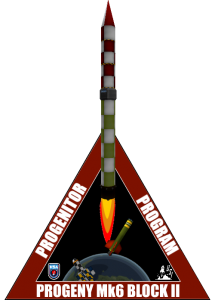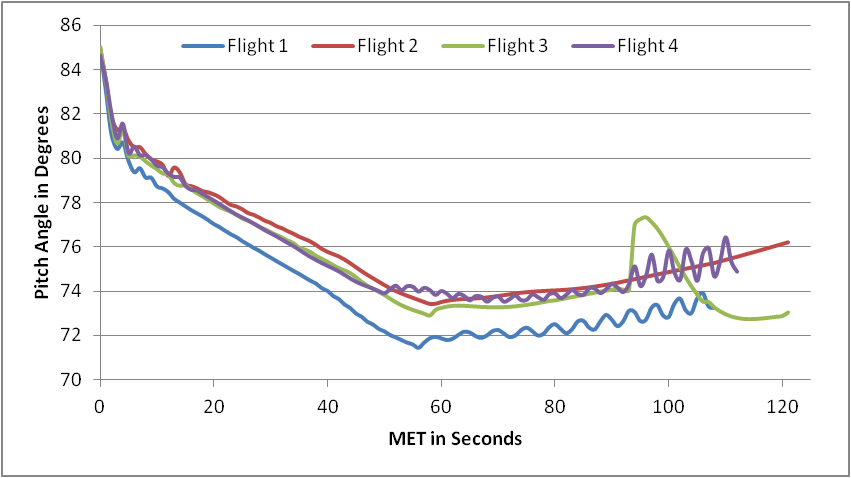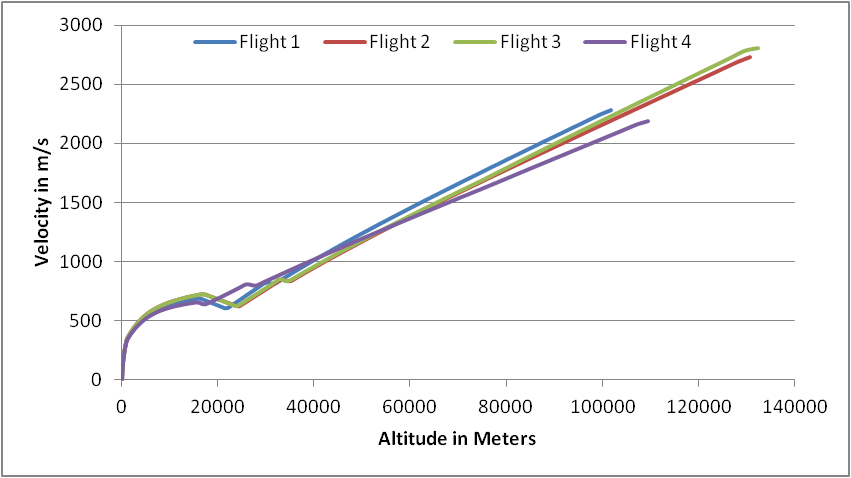 The Block II was brought back into service after what was thought to be its final flight back in 2019 in order to carry up some payloads for the Kerbal Sounding Project. While 4 Mk6 Block I rockets handled the launch of KSP instruments in 2019, this past year’s program wanted to give the student builders the opportunity to send their designs higher than before aboard the Block II. Despite the buyout of USI enough surplus parts remained to construct the rocket and the new owner Luciole was able to produce more on demand if needed – which was good because it was needed when during wet dress rehearsal an equipment malfunction on the fuel truck caused an explosion that damaged the rocket.
The Block II was brought back into service after what was thought to be its final flight back in 2019 in order to carry up some payloads for the Kerbal Sounding Project. While 4 Mk6 Block I rockets handled the launch of KSP instruments in 2019, this past year’s program wanted to give the student builders the opportunity to send their designs higher than before aboard the Block II. Despite the buyout of USI enough surplus parts remained to construct the rocket and the new owner Luciole was able to produce more on demand if needed – which was good because it was needed when during wet dress rehearsal an equipment malfunction on the fuel truck caused an explosion that damaged the rocket.
The mission was pushed into this year while new solid rocket motors were manufactured to replace the ones that were damaged by shrapnel. Thankfully the final stage was high enough to escape harm as that would have been more costly and time-consuming to replace. Once repaired it was rolled out again, WDR this time went without a hitch and favorable weather on launch day posed no further delays.
The Flight
It was a beautiful night to again see this rocket soar up into the sky with a huge tail of flame shooting out from the 5 solid rocket motors that had ignited to push it off the pad with 135kN of thrust at 6Gs, keeping the nose high. The 4 radial boosters burned out after only 6s and fell away cleanly as the core booster continued to burn and accelerate the rocket through Mach 1 less than 10s into the flight. The sonic boom rippled across the grounds at KSC.
As the rocket cleared through 4.5km it withstood a max dynamic pressure of 83.202kPa, which began to fall as the air continued to thin and the core booster continued to taper off its thrust from 66kN down to 18kN as the burn carried on for the next 28s. A second after burnout at 17km the first stage was decoupled and unlike previous ascent profiles the coast stage was skipped and the second stage engine was immediately ignited to maintain the rocket’s momentum.
A 13s boost from the second solid stage putting out 14.7kN took the rocket up to 26km traveling at over 800m/s when it was decoupled from the rocket and the third stage liquid-fueled engine ignited to continue the push upwards with 12kN of force for 2.6 TWR. All stages had separated cleanly and the rocket was in a stable rotation along its longitudinal axis averaging less than 1° in angle of attack. Pitch angle remained high thanks to the hot staging through the ascent.
The rocket flew out of the atmosphere at L+1m30s with a velocity of 1.5km/s while still accelerating, releasing its upper fairing halves to expose the instruments to space. The engine continued to burn at full throttle for another 22s before running out of propellants and shutting down. The rocket was now coasting upwards toward an apokee of only 805km, a far cry from the 4.3Mm it achieved on its last flight or even the 3.1Mm from the flight before that.
Still, it was high enough that even over the night side where the radiation belts are stretched further from the planet the rocket was still expected to reach at least the inner belt to satisfy mission objectives. Just a few seconds after the final engine cut off the flight computer began its hibernation cycle, which would conserve the limited battery power during the long coast phase. Because of how high the rocket flew last time and it almost running out of power with 30s sleep intervals, this mission’s interval was increased back to the 60s from the second mission.
Unfortunately while the hibernation cycle showed no problems, by the time the rocket reached apokee at L+15m48s the radiation levels had failed to increase by any large margin beyond normal background levels. Without encountering the belt on the way up it was highly unlikely the rocket would do so on the way down but everyone remained hopeful. Again, unfortunately, hopes were dashed as what little increase there was detected in radiation returned to normal background levels as the rocket plummeted back down through 300km.
At L+29m38s the rocket woke up after yet another cycle of slumber and realized it was soon to pass below 100km and re-entry would be coming up next so it stayed awake. Atmospheric interface occurred at L+30m03s and by now the rocket’s spin precession had laid it out to rotate in a flat spin. Traveling at 2.4km/s meant that air friction quickly generated a radio-blocking plasma to cut off communications only 9s later as it plummeted down towards the central Kerblantic. With that the mission was concluded and had to be marked as a failure for not entering a high-radiation region. Although the rocket did carry a parachute for payload recovery in the event of an ascent abort, it was not meant to be used for recovery from space.
Flight Analysis
Ascent Profile
The disappointing apokee was also the lowest apokee of all 4 flights for the Block II, despite the fact that this rocket was only the second-heaviest to be launched, as shown below:

Launch mass
Because this rocket was heavier than the previous two that made it several Mm high, the second stage coast phase was skipped to allow the rocket to continue to build velocity and maintain a pitch angle closer to the ones that were followed by these two previous flights. In this, it was successful:
However there’s a tradeoff for speed in the lower atmosphere vs. pitch later in the flight. The more vertical a rocket is the more it’s fighting against gravity, the more horizontal it is the faster it can pick up speed but it also doesn’t travel as high. However the higher speed can still mean a higher apokee if you don’t pitch over too much. You can see this is where things went wrong for this flight:
So the heavier rocket succeeded in going faster than the two lighter flights at a lower altitude but as it continued to climb during its third stage it failed to accelerate as quickly. It even failed to keep pace with the heavier first flight, because as you can see in the graph plotting pitch that rocket turned over more to use Kerbin’s spin to pick up more speed, but the greater turn-over also led to it not breaking 1Mm in apokee.
In conclusion, the main factor in the failure to reach an apokee as high as several Mm lies in that the rocket could not control its pitch during flight. If it had been able to begin pitching over more at the start of its third stage burn when it was moving faster than the rest, it could have continued to increase its acceleration past that of its predecessors and still reach as high as those with lighter payloads.
Missed Radiation Belt
Current models of the inner radiation belt based on previous missions to explore it show that on the night side it should have been reachable within the apokee that the rocket achieved. The rocket’s inclination was <1° and previous missions up to 43° have made contact with the inner belt so the only conclusion that we can reach is it simply was not there.
How is this possible? Well there are two competing theories. First is that the inner belt is not persistent. It may wax and wane over a period of time and possibly disappear altogether for a while sometimes. Second is that the belt is tilted with respect to the geomagnetic pole, which does not run straight through the geographic poles and is offset 9.63°. Stronger evidence from past missions points to the second theory as links have been made between the radiation belts and the planet’s magnetosphere (such as the aurora) but we certainly don’t know enough about the belts on a long-term basis to rule out the first theory.
While the radiation levels measured by the rocket did increase ever so slightly from background levels of 1.428mrad/hr to as high as 3.657mrad/hr, this was nowhere near the levels of the inner belt, which in the past have been recorded as high as 10rad/hr. Still, it shows that either the rocket did enter the belt and it was just not “fully charged” during this period of time or that it came within the vicinity of the belt, but the actual belt was above or below it due to being tilted out of plane. Since a tilted belt would rotate with the planet and sweep through a wide area of space it wouldn’t always occupy, the increase in rads could also just be residual radiation left behind during the belt’s wobbling orbit.
Future Plans
While the mission may have failed, it certainly posed some interesting new questions about the radiation environment around the planet, which appears to be more complex than originally supposed. Thankfully getting answers shouldn’t take too much longer as the Kerbin III probe is already being prepared for its mission next month, which will explore the radiation belts over several weeks and hopefully longer if the equipment lasts.
The lack of a good ascent shows just how frustrating it can be to operate rockets with minimal steering capabilities and this is why the Mk6, although our longest-working rocket to date with 3 years of service history, is being retired in favor of the guided Mk8.









